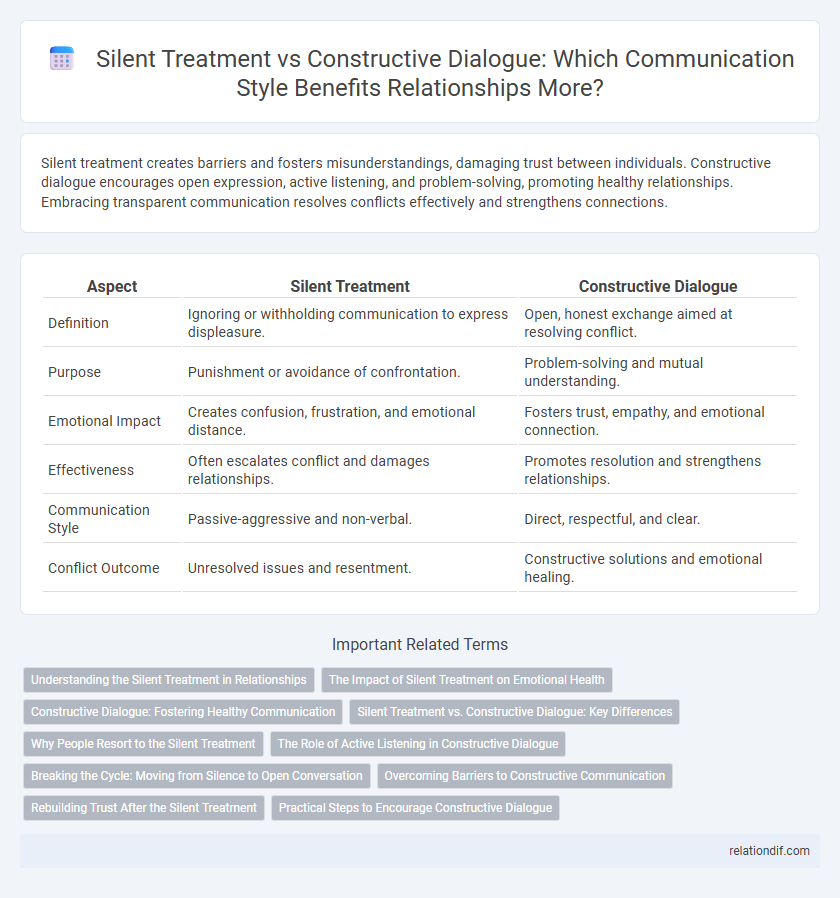Silent treatment creates barriers and fosters misunderstandings, damaging trust between individuals. Constructive dialogue encourages open expression, active listening, and problem-solving, promoting healthy relationships. Embracing transparent communication resolves conflicts effectively and strengthens connections.
Table of Comparison
| Aspect | Silent Treatment | Constructive Dialogue |
|---|---|---|
| Definition | Ignoring or withholding communication to express displeasure. | Open, honest exchange aimed at resolving conflict. |
| Purpose | Punishment or avoidance of confrontation. | Problem-solving and mutual understanding. |
| Emotional Impact | Creates confusion, frustration, and emotional distance. | Fosters trust, empathy, and emotional connection. |
| Effectiveness | Often escalates conflict and damages relationships. | Promotes resolution and strengthens relationships. |
| Communication Style | Passive-aggressive and non-verbal. | Direct, respectful, and clear. |
| Conflict Outcome | Unresolved issues and resentment. | Constructive solutions and emotional healing. |
Understanding the Silent Treatment in Relationships
Silent treatment in relationships often signals unresolved conflicts and emotional withdrawal, leading to increased misunderstanding and distancing between partners. Recognizing this behavior as a form of passive-aggressive communication helps in addressing underlying issues and preventing long-term damage. Constructive dialogue fosters healthier emotional expression, promoting empathy and mutual resolution.
The Impact of Silent Treatment on Emotional Health
Silent treatment often leads to increased feelings of anxiety, depression, and emotional isolation, severely damaging interpersonal relationships. Constructive dialogue promotes emotional well-being by fostering understanding, empathy, and conflict resolution. Research indicates that open communication reduces stress hormones and enhances psychological resilience.
Constructive Dialogue: Fostering Healthy Communication
Constructive dialogue promotes healthy communication by encouraging open, honest exchanges that build trust and understanding between parties. Techniques such as active listening, empathy, and clear expression of feelings help resolve conflicts effectively without escalation. Unlike silent treatment, constructive dialogue fosters emotional connection and collaborative problem-solving, leading to stronger relationships and improved outcomes.
Silent Treatment vs. Constructive Dialogue: Key Differences
Silent treatment involves withholding communication, creating emotional distance and unresolved tension, while constructive dialogue promotes open expression, understanding, and problem-solving. Silent treatment often leads to miscommunication and increased conflict, whereas constructive dialogue facilitates empathy and collaboration. Effective communication relies on timely engagement and active listening, contrasting sharply with the isolation caused by silent treatment.
Why People Resort to the Silent Treatment
People often resort to the silent treatment as a defense mechanism to avoid confrontation and protect themselves from emotional vulnerability. This behavior can stem from feelings of anger, frustration, or fear of expressing true emotions constructively. Understanding the underlying reasons helps shift communication towards more effective and empathetic dialogue, fostering healthier relationships.
The Role of Active Listening in Constructive Dialogue
Active listening plays a crucial role in transforming conflict into constructive dialogue by fostering empathy and understanding between parties. It involves fully concentrating, reflecting, and responding thoughtfully, which breaks down barriers created by the silent treatment. Emphasizing active listening can lead to more effective communication, conflict resolution, and stronger relationships.
Breaking the Cycle: Moving from Silence to Open Conversation
Breaking the cycle of the silent treatment requires fostering safe spaces for honest expression and active listening, which leads to deeper understanding and trust in relationships. Constructive dialogue encourages emotional vulnerability and conflict resolution by addressing issues directly rather than avoiding them. Prioritizing open communication enhances connection and prevents misunderstandings from festering into resentment.
Overcoming Barriers to Constructive Communication
Silent treatment creates barriers by fostering misunderstanding and emotional distance, hindering effective communication. Constructive dialogue promotes active listening, empathy, and clarity, enabling individuals to resolve conflicts and build trust. Overcoming communication barriers requires intentional efforts to express feelings openly and engage in respectful conversations.
Rebuilding Trust After the Silent Treatment
Rebuilding trust after the silent treatment requires open, honest communication and consistent emotional availability. Constructive dialogue fosters understanding by encouraging vulnerability and active listening, which helps repair damaged relationships. Establishing clear boundaries and expressing needs respectfully are crucial steps in restoring connection and preventing future breakdowns.
Practical Steps to Encourage Constructive Dialogue
Encouraging constructive dialogue involves setting clear communication goals, actively listening without interruption, and expressing thoughts with empathy and honesty. Implementing regular check-ins creates a safe space for open conversation, reducing misunderstandings and the tendency toward silent treatment. Utilizing "I" statements helps individuals take ownership of their feelings, fostering mutual respect and collaboration.
silent treatment vs constructive dialogue Infographic

 relationdif.com
relationdif.com